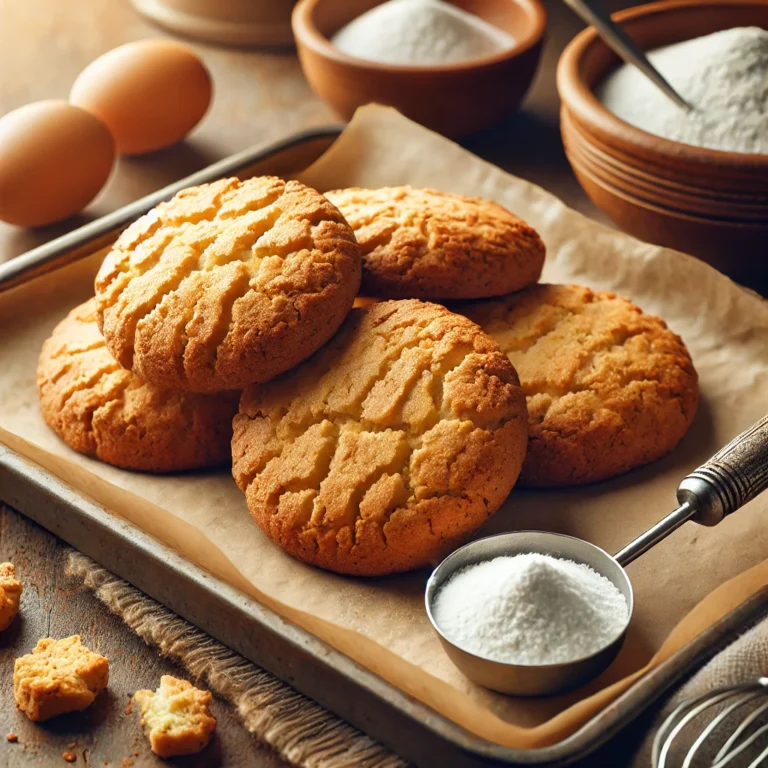Baking powder is one of the most essential leavening agents in baking, especially when it comes to cookies. But what exactly does baking powder do to cookies? Does it make them rise, spread, or become soft? If you’ve ever wondered how baking powder affects the texture, flavour, and overall structure of your cookies, this guide will give you all the answers!
What Is Baking Powder?
Baking powder is a chemical leavening agent made up of three key ingredients:
- Baking soda (sodium bicarbonate) – A base that creates carbon dioxide when mixed with an acid.
- Acidic component (cream of tartar or monocalcium phosphate) – Reacts with baking soda to produce gas.
- A filler (usually cornstarch) – Prevents the reaction from happening too soon by keeping the ingredients dry.

How Does Baking Powder Work in Cookies?
Baking powder helps cookies rise and become lighter by producing carbon dioxide gas when it reacts with moisture and heat. This gas forms air pockets in the dough, leading to a softer, fluffier texture.
Key Effects of Baking Powder in Cookies:
- Creates a Soft and Puffy Texture – Unlike baking soda, which encourages spreading, baking powder helps cookies rise and remain soft.
- Reduces Spread – Cookies with baking powder don’t spread as much, leading to thicker, more cake-like cookies.
- Adds a Slightly Airy Texture – The gas bubbles formed during baking make the cookies slightly lighter.
- Affects Browning – Baking powder can neutralize acidity, which might result in lighter-coloured cookies compared to those made with baking soda.

Baking Powder vs. Baking Soda in Cookies
Many people confuse baking powder and baking soda, but they work differently in baking. Here’s how they compare:
| Feature | Baking Powder | Baking Soda |
|---|---|---|
| Type | Leavening agent with acid already included | Needs an acid to activate |
| Effect on Cookies | Creates a soft, cake-like texture | Leads to spread and crispiness |
| Flavor Impact | Neutral taste | Slightly salty, sometimes bitter |
| Browning | Less browning | Promotes browning |
How Much Baking Powder Should You Use in Cookies?
The amount of baking powder needed depends on the recipe. As a general rule:
- For soft, puffy cookies – Use about 1 to 1.5 teaspoons per cup of flour.
- For slightly crisp cookies with a bit of rise – Use 1/2 teaspoon per cup of flour.
- For chewy cookies – Reduce baking powder or use baking soda instead.
Using too much baking powder can cause cookies to taste metallic and rise too much, only to collapse later.
What Happens If You Don’t Use Baking Powder in Cookies?
If a recipe calls for baking powder and you leave it out, the cookies may turn out:
- Flatter and denser – Since there’s no leavening agent to create air pockets.
- Crispier – Without the rising effect, the dough spreads more, creating a thinner texture.
-
Less soft and fluffy – The cookies won’t have the same airy feel.
Best Types of Cookies to Use Baking Powder In
While baking soda is great for chewy cookies, baking powder is best for:
- Soft sugar cookies
- Cake-like chocolate chip cookies
- Shortbread cookies
- Snickerdoodles (if you want them softer rather than crispier)
If you’re after a thick, pillowy cookie, baking powder is your best friend!

Frequently Asked Questions (FAQs)
1. Can I substitute baking soda for baking powder in cookies?
Yes, but you’ll need to add an acid (like lemon juice or vinegar) to activate it. Generally, use 1/4 teaspoon of baking soda for every 1 teaspoon of baking powder and add a little acid to balance it out.
2. What happens if I use both baking powder and baking soda?
Using both can give the best of both worlds—some lift from the baking powder and some spread and browning from the baking soda. Many chocolate chip cookie recipes use both for a balanced texture.
3. Can I make cookies without any leavening agents?
Yes! Cookies without baking powder or baking soda tend to be denser, chewier, and more buttery. Shortbread and some sugar cookies are great examples.

Baking powder plays a crucial role in determining the texture of cookies, making them softer, thicker, and less spread out. By understanding how baking powder works, you can tweak your recipes to create the perfect cookie every time!
If you found this guide helpful, share it with your baking friends and try experimenting with different cookie recipes. Happy baking! 🍪




